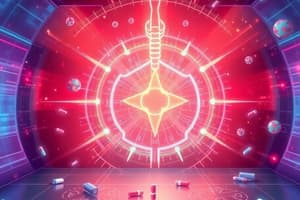Podcast
Questions and Answers
What is the primary effect of anticonvulsants such as Phenytoin and carbamazepine?
What is the primary effect of anticonvulsants such as Phenytoin and carbamazepine?
- Reduce inflammation
- Relieve nausea
- Inhibit convulsions (correct)
- Prevent depression
Which medication is classified under antidepressants?
Which medication is classified under antidepressants?
- Trimethobenzamide Hydrochloride
- Fosphenytoin
- Prochlorperazine
- Amitriptyline (correct)
What common side effect might be expected from the use of antidepressants?
What common side effect might be expected from the use of antidepressants?
- Rash
- Slurred speech
- Drowsiness (correct)
- Blurred vision
What is the purpose of antiembolic medications?
What is the purpose of antiembolic medications?
What side effect is NOT commonly associated with anticonvulsants?
What side effect is NOT commonly associated with anticonvulsants?
What is the primary purpose of beta-blockers?
What is the primary purpose of beta-blockers?
Which of the following is a possible toxic effect of medications?
Which of the following is a possible toxic effect of medications?
Which medication category is primarily used to treat allergic reactions?
Which medication category is primarily used to treat allergic reactions?
What kind of effects are idiosyncratic effects?
What kind of effects are idiosyncratic effects?
What precaution should radiographers take regarding medications?
What precaution should radiographers take regarding medications?
What is the primary reason for a radiographer to be familiar with drug names and dosages?
What is the primary reason for a radiographer to be familiar with drug names and dosages?
Which statement best differentiates between drugs and medications?
Which statement best differentiates between drugs and medications?
What role do proprietary names play in medication identification?
What role do proprietary names play in medication identification?
What should radiographers recognize when observing medication reactions?
What should radiographers recognize when observing medication reactions?
Why is it important for radiographers to understand both generic and trade names of drugs?
Why is it important for radiographers to understand both generic and trade names of drugs?
What does pharmacokinetics encompass in the context of medication?
What does pharmacokinetics encompass in the context of medication?
Which of the following best describes pharmacodynamics?
Which of the following best describes pharmacodynamics?
What role does the FDA play concerning medications?
What role does the FDA play concerning medications?
How can medications produce different types of effects on the body?
How can medications produce different types of effects on the body?
Which of the following statements about medication effects is accurate?
Which of the following statements about medication effects is accurate?
What should never be administered to children in a radiology department without a physician's order?
What should never be administered to children in a radiology department without a physician's order?
Which sedative is commonly prescribed for its amnesia and sedation properties?
Which sedative is commonly prescribed for its amnesia and sedation properties?
For adult patients, what is the maximum dosage of lorazepam that should be administered?
For adult patients, what is the maximum dosage of lorazepam that should be administered?
What is the purpose of using lidocaine in medical procedures?
What is the purpose of using lidocaine in medical procedures?
Which type of agent is succinylcholine chloride classified as?
Which type of agent is succinylcholine chloride classified as?
What is the primary treatment for type 1 diabetes?
What is the primary treatment for type 1 diabetes?
Which of the following classes of medications is primarily used to lower blood pressure?
Which of the following classes of medications is primarily used to lower blood pressure?
What is the role of antagonists in medication?
What is the role of antagonists in medication?
What is a common side effect of analgesics?
What is a common side effect of analgesics?
Which of the following medications is classified as an anticonvulsant?
Which of the following medications is classified as an anticonvulsant?
What is the primary effect of vasodilators?
What is the primary effect of vasodilators?
Which medication is commonly used as a sedative?
Which medication is commonly used as a sedative?
What condition are antimicrobials primarily used to treat?
What condition are antimicrobials primarily used to treat?
Which of the following is a common side effect of skeletal muscle relaxants?
Which of the following is a common side effect of skeletal muscle relaxants?
What is the main purpose of tranquilizers?
What is the main purpose of tranquilizers?
Which side effect is commonly associated with sedatives?
Which side effect is commonly associated with sedatives?
What common side effect is associated with Adrenergics like Epinephrine?
What common side effect is associated with Adrenergics like Epinephrine?
Which medication is primarily used for managing severe allergic reactions when other treatments fail?
Which medication is primarily used for managing severe allergic reactions when other treatments fail?
What is a potential side effect of analgesics like Ibuprofen?
What is a potential side effect of analgesics like Ibuprofen?
How is Epinephrine commonly administered in urgent situations?
How is Epinephrine commonly administered in urgent situations?
What key aspect must physicians consider when prescribing new medications?
What key aspect must physicians consider when prescribing new medications?
Which of the following is a characteristic of corticosteroids?
Which of the following is a characteristic of corticosteroids?
What side effect is noted for anticholinergic medications like Atropine?
What side effect is noted for anticholinergic medications like Atropine?
Which category of medication is primarily used to manage heart rhythm issues?
Which category of medication is primarily used to manage heart rhythm issues?
What is the maximum daily oral dose of Diphenhydramine for adults?
What is the maximum daily oral dose of Diphenhydramine for adults?
What is an important consideration regarding medication dosages?
What is an important consideration regarding medication dosages?
Flashcards
Medication
Medication
A substance prescribed for treatment and produces therapeutic effects.
Drug
Drug
A general term for substances used in diagnosis, treatment, or prevention of disease.
Generic name
Generic name
Identifies a drug's chemical family.
Brand name
Brand name
Signup and view all the flashcards
Why do radiographers need to know medication information?
Why do radiographers need to know medication information?
Signup and view all the flashcards
Pharmacokinetics
Pharmacokinetics
Signup and view all the flashcards
Pharmacodynamics
Pharmacodynamics
Signup and view all the flashcards
Therapeutic Effect
Therapeutic Effect
Signup and view all the flashcards
Side Effect
Side Effect
Signup and view all the flashcards
Adverse Reaction
Adverse Reaction
Signup and view all the flashcards
Anticonvulsants
Anticonvulsants
Signup and view all the flashcards
Antidepressants
Antidepressants
Signup and view all the flashcards
Antiembolics
Antiembolics
Signup and view all the flashcards
Phenytoin (Dilantin)
Phenytoin (Dilantin)
Signup and view all the flashcards
Amitriptyline (Elavil)
Amitriptyline (Elavil)
Signup and view all the flashcards
Analgesics
Analgesics
Signup and view all the flashcards
Antimicrobials
Antimicrobials
Signup and view all the flashcards
Antiarrhythmics
Antiarrhythmics
Signup and view all the flashcards
Sedatives
Sedatives
Signup and view all the flashcards
Skeletal Muscle Relaxants
Skeletal Muscle Relaxants
Signup and view all the flashcards
Tranquilizers
Tranquilizers
Signup and view all the flashcards
Vasodilators
Vasodilators
Signup and view all the flashcards
NSAIDs
NSAIDs
Signup and view all the flashcards
Sedatives and Tranquilizers
Sedatives and Tranquilizers
Signup and view all the flashcards
Lorazepam (Ativan) and Diazepam (Valium)
Lorazepam (Ativan) and Diazepam (Valium)
Signup and view all the flashcards
Midazolam (Versed)
Midazolam (Versed)
Signup and view all the flashcards
Antagonists
Antagonists
Signup and view all the flashcards
Lidocaine (Xylocaine)
Lidocaine (Xylocaine)
Signup and view all the flashcards
Paralytic Agents
Paralytic Agents
Signup and view all the flashcards
Idiosyncratic Effect
Idiosyncratic Effect
Signup and view all the flashcards
Toxic Effects
Toxic Effects
Signup and view all the flashcards
Adrenergics
Adrenergics
Signup and view all the flashcards
Anticholinergics
Anticholinergics
Signup and view all the flashcards
Diphenhydramine (Benadryl)
Diphenhydramine (Benadryl)
Signup and view all the flashcards
Corticosteroids
Corticosteroids
Signup and view all the flashcards
Epinephrine (Adrenalin)
Epinephrine (Adrenalin)
Signup and view all the flashcards
Methylprednisolone (Solu-Medrol)
Methylprednisolone (Solu-Medrol)
Signup and view all the flashcards
What are important considerations when using medications in radiology?
What are important considerations when using medications in radiology?
Signup and view all the flashcards
Why is it essential to inform the physician about all medications you're taking?
Why is it essential to inform the physician about all medications you're taking?
Signup and view all the flashcards
What is the main purpose of the medication table provided?
What is the main purpose of the medication table provided?
Signup and view all the flashcards




